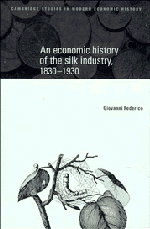Book contents
- Frontmatter
- Contents
- List of illustrations
- List of tables
- Forward and acknowledgments
- List of abbreviations
- 1 Introduction
- 2 The characteristics of the industry
- 3 The growth in the long run
- 4 Consumption of silkwares and demand for silk
- 5 The demand for silk: an analysis by country
- 6 The roots of growth: agricultural production
- 7 The industry: technical progress and structural change
- 8 Institutions and competitiveness: the markets
- 9 Institutions and competitiveness: the state
- 10 Conclusions
- Statistical appendix
- References
- Index
9 - Institutions and competitiveness: the state
Published online by Cambridge University Press: 29 January 2010
- Frontmatter
- Contents
- List of illustrations
- List of tables
- Forward and acknowledgments
- List of abbreviations
- 1 Introduction
- 2 The characteristics of the industry
- 3 The growth in the long run
- 4 Consumption of silkwares and demand for silk
- 5 The demand for silk: an analysis by country
- 6 The roots of growth: agricultural production
- 7 The industry: technical progress and structural change
- 8 Institutions and competitiveness: the markets
- 9 Institutions and competitiveness: the state
- 10 Conclusions
- Statistical appendix
- References
- Index
Summary
Introduction
The production of silk has always been specially cared for by governments all over the world. In China, it was a state monopoly until 1150 BC, and only the Emperor and the court could wear silk dresses. In Japan, the help of the central government and of daymios, eager to substitute imports from China, was instrumental in the recovery of the production in the seventeenth and eighteenth centuries from the crisis caused by the previous centuries of political turmoil. At the same time many European governments tried to foster the development of silk production, because they deemed imports of silk and silkwares particularly harmful to the trade balance. The France of Henry the IV and Sully led the way at the end of the sixteenth century, imitated some decades later by James Fs Great Britain and afterwards by Germany, the Netherlands and Sweden. Only France succeeded in developing a commercial production of silk, because elsewhere the climate was, as already said, unsuited to sericulture. These failures, jointly with the general crisis of mercantilism towards the end of the eighteenth century, halted the efforts in Europe. The British and French governments turned to their colonies (the former to the United States and India, the latter to Madagascar, the Reunion Islands and Indochina), hoping to find there a better environment – but with little or no success. After some decades of neglect, the idea of promoting sericulture was revived in the late nineteenth century. The silk-importing countries wanted to become self-sufficient.
- Type
- Chapter
- Information
- An Economic History of the Silk Industry, 1830–1930 , pp. 174 - 190Publisher: Cambridge University PressPrint publication year: 1997

